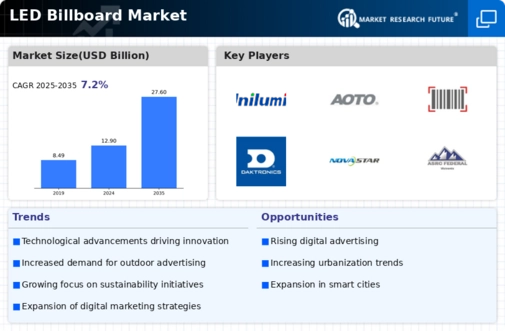Market Growth Projections
The Global LED Billboard Market Industry is poised for substantial growth, with projections indicating a market size of 12.9 USD Billion in 2024 and an anticipated increase to 27.6 USD Billion by 2035. This growth is underpinned by a compound annual growth rate of 7.17% from 2025 to 2035. The increasing adoption of LED technology in advertising, coupled with urbanization and advancements in digital signage, suggests a robust market landscape. As businesses continue to invest in innovative advertising solutions, the demand for LED billboards is likely to rise, reflecting the evolving nature of consumer engagement and advertising strategies.
Technological Advancements
The Global LED Billboard Market Industry is experiencing rapid technological advancements, which enhance the quality and effectiveness of advertising. Innovations such as high-resolution displays, energy-efficient LED technology, and smart connectivity features are becoming increasingly prevalent. These advancements allow advertisers to deliver more engaging and dynamic content, thereby attracting greater consumer attention. As a result, the market is projected to reach 12.9 USD Billion in 2024, reflecting a growing demand for cutting-edge advertising solutions. Furthermore, the integration of artificial intelligence and data analytics into LED billboards is likely to optimize ad placements and improve targeting, further driving market growth.
Increased Advertising Budgets
The Global LED Billboard Market Industry is benefiting from increased advertising budgets across various sectors. As businesses recognize the effectiveness of LED billboards in reaching target audiences, they are allocating more resources to digital advertising. This trend is particularly evident in sectors such as retail, entertainment, and automotive, where visual impact is crucial. The shift towards digital advertising is expected to drive significant growth in the market, with a projected increase to 12.9 USD Billion in 2024. The ability of LED billboards to deliver real-time content and engage consumers in innovative ways further enhances their appeal, leading to higher advertising expenditures.
Consumer Engagement and Experience
The emphasis on consumer engagement and experience is a driving force behind the Global LED Billboard Market Industry. Advertisers are increasingly focused on creating memorable experiences that resonate with audiences. LED billboards, with their vibrant colors and dynamic content, are well-suited for capturing attention and fostering engagement. This trend is particularly relevant in high-traffic areas where competition for consumer attention is fierce. As brands seek to differentiate themselves, the use of LED technology is likely to become more prevalent. The market's growth trajectory, with expectations of reaching 27.6 USD Billion by 2035, reflects the importance of engaging consumers through innovative advertising solutions.
Regulatory Support for Digital Advertising
Regulatory frameworks are increasingly supportive of digital advertising, which positively impacts the Global LED Billboard Market Industry. Governments are recognizing the potential of LED billboards to enhance urban landscapes and promote local businesses. Policies that facilitate the installation and operation of digital signage are being enacted, thereby encouraging investment in this sector. This regulatory support is likely to foster a conducive environment for market growth, as businesses seek to leverage LED technology for advertising. The anticipated compound annual growth rate of 7.17% from 2025 to 2035 underscores the potential for sustained expansion in the industry.
Urbanization and Infrastructure Development
Urbanization plays a pivotal role in the expansion of the Global LED Billboard Market Industry. As cities grow and infrastructure develops, the demand for effective advertising solutions increases. Urban areas, characterized by high foot traffic and dense populations, provide ideal environments for LED billboards. Governments worldwide are investing in smart city initiatives, which often include the installation of digital signage. This trend is expected to contribute significantly to the market's growth, with projections indicating a rise to 27.6 USD Billion by 2035. The combination of urbanization and infrastructure development creates a fertile ground for the proliferation of LED advertising.












